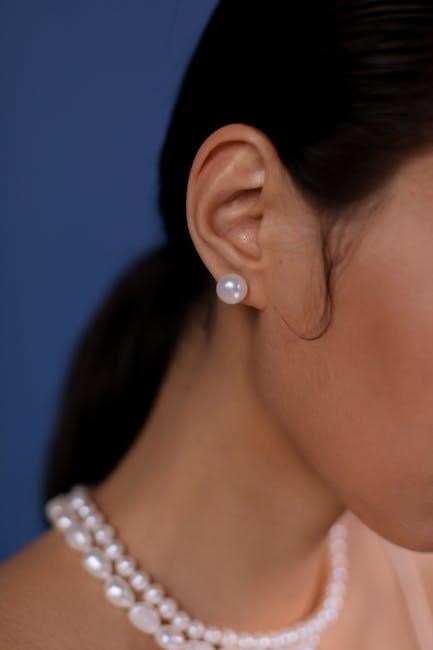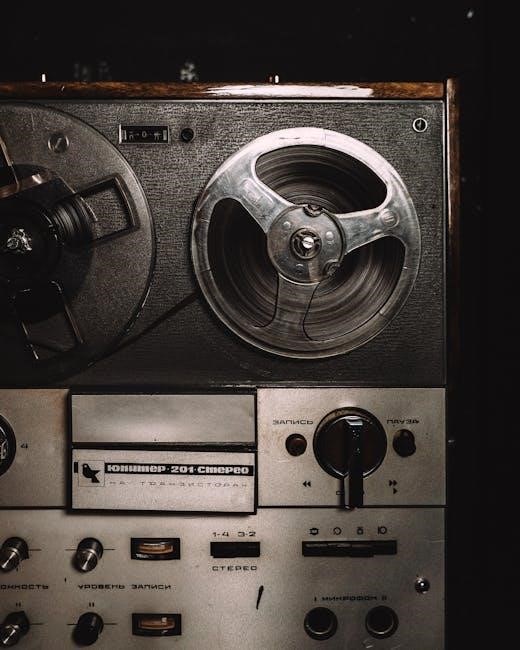Ear gauges are jewelry pieces used to create and maintain larger ear holes. They come in various materials and styles, allowing individuals to personalize their appearance. Popular for their versatility, ear gauges offer a unique way to express personal style through different designs and sizes.
1.1 What Are Ear Gauges?
Ear gauges are cylindrical jewelry pieces designed to create and maintain stretched earlobes. They consist of a wearable ring with two ends, often secured by O-rings, and are available in various materials and sizes. Ear gauges are used to gradually enlarge the ear piercing, allowing individuals to achieve their desired aesthetic. Unlike traditional earrings, gauges are specifically crafted for stretched ears and come in styles such as single flare, double flare, and straight designs. They are popular for their versatility and customization options, making them a favorite among those who enjoy body modification. Ear gauges can be made from materials like stainless steel, glass, or wood, catering to different preferences and lifestyles; Proper sizing and aftercare are essential to ensure comfort and prevent complications. Ear gauges have become a meaningful way for people to express their identity and personal style through unique and eye-catching designs.
1.2 Historical Background of Ear Gauges
Ear gauges have a rich history tracing back thousands of years, originating in ancient civilizations. Cultures like the Aztecs, Mayans, and tribes in Africa and Asia practiced ear stretching as a symbol of status, spirituality, or cultural identity. These early gauges were often made from natural materials such as wood, bone, or stone. In many societies, larger ear holes signified wisdom, power, or spiritual connection. The practice was also linked to rites of passage, marking important life events. Over time, ear gauges evolved and spread globally, adapting to different cultural influences. In modern times, they became popular in the 1980s and 1990s within the punk and alternative movements, symbolizing rebellion and self-expression. Today, ear gauges are worn worldwide, blending traditional techniques with contemporary designs and materials, making them a timeless form of body art. Their enduring appeal lies in their historical roots and personal significance.

Types of Ear Gauges
Ear gauges come in various styles, including plug, tunnel, and captive bead designs. Each type offers a unique aesthetic, catering to personal preferences and lifestyle needs while maintaining ear hole integrity and comfort.
2.1 Materials Used for Ear Gauges
Ear gauges are crafted from a variety of materials, each offering unique benefits and aesthetics. Surgical stainless steel is a popular choice due to its durability and resistance to corrosion. Titanium gauges are hypoallergenic, making them ideal for sensitive skin. Glass gauges are smooth and non-irritating, often used for healing or as a stylish alternative. Acrylic and resin gauges are lightweight and come in vibrant colors, appealing to those who enjoy fashion-forward designs. Organic materials like wood and bone are favored for their natural, earthy appearance. Platinum and gold gauges provide a luxurious option, with gold often plated over base metals for affordability. Silicone gauges are flexible and comfortable, suitable for everyday wear. Each material caters to different preferences, lifestyles, and budgets, ensuring there’s an option for everyone looking to personalize their ear jewelry.
2.2 Styles and Designs of Ear Gauges
Ear gauges are available in a wide variety of styles and designs, catering to diverse preferences and aesthetics. From sleek and minimalist plugs to elaborate tunnels adorned with intricate details, there’s a design to suit every taste. Popular styles include spiral gauges, which twist into the ear, and carved designs that add a touch of artistry. Many gauges feature gemstones, wood, or glass accents, offering a decorative flair. Tunnels and teardrops are also favored for their unique silhouettes, while flush-fit gauges provide a subtle, low-profile look. The choice of design often reflects personal style, cultural influences, or lifestyle, making ear gauges a versatile form of self-expression. Additionally, some designs incorporate hypoallergenic materials, ensuring comfort for sensitive skin. With countless options available, individuals can explore different looks to match their identity or wardrobe seamlessly.
Ear Gauge Sizing and Measurement
Ear gauges are measured in specific sizes, with standard gauges ranging from 20g to 00g. The larger the number, the smaller the diameter, with 0g being the largest common size.
3.1 Standard Ear Gauge Sizes
Standard ear gauge sizes are measured in gauges, with smaller numbers indicating larger diameters. The most common sizes range from 20 gauge (0.81 mm) to 00 gauge (10.2 mm). These sizes provide a guide for individuals to choose the appropriate jewelry for their ear piercing. Starting with smaller gauges is often recommended to allow for gradual stretching and to minimize the risk of complications. The sizes increase incrementally, making it easier to track progress and maintain consistency.
Understanding standard sizes is essential for selecting the right jewelry and ensuring proper fit. Each gauge size corresponds to a specific millimeter measurement, which helps in determining the correct jewelry diameter. This standardization allows for uniformity across different brands and styles, ensuring compatibility and ease of use. Whether starting with a smaller size or aiming for a larger gauge, knowing the standard measurements is crucial for achieving the desired aesthetic safely and effectively.
3.2 Understanding Gauge vs. Millimeter
Ear gauge sizing can be confusing due to the difference between gauge and millimeter measurements. The gauge system works inversely, meaning a lower gauge number represents a larger diameter. For example, a 16-gauge ear piercing is smaller than a 0-gauge. In contrast, millimeter measurements are straightforward, with larger numbers indicating bigger sizes. Understanding this distinction is crucial for selecting the right ear gauges. Many people mistakenly assume that gauge and millimeter measurements are interchangeable, but they are not. Knowing whether your ear piercing is measured in gauge or millimeters will help you choose the correct jewelry size. Accurate measurements are essential to avoid complications like improper fit or tissue damage. Always use a gauge wheel or plug chart to determine your size accurately. This ensures your ear gauges fit comfortably and maintain the health of your piercings.

How to Choose the Right Ear Gauge
Consider personal style, durability, and comfort. Choose materials suitable for your lifestyle. Ensure proper fit and consider jewelry material for long-term wear. Select designs that align with your aesthetic preferences and needs.
4.1 Factors to Consider When Selecting Ear Gauges
When choosing ear gauges, several factors come into play to ensure the best fit and satisfaction. Material is a primary consideration, as options like stainless steel, glass, or organic materials vary in comfort and durability. Size is crucial, as it determines the appearance and comfort level. Comfort and durability are intertwined, with some materials being more hypoallergenic or suitable for long-term wear. Style is another key factor, as designs range from minimalist to decorative, catering to different aesthetics. Lifestyle plays a role too, as active individuals may prefer sturdy, low-maintenance options. Budget is also important, as prices vary based on material and craftsmanship. Lastly, aftercare needs should be considered to maintain ear health and jewelry longevity. By evaluating these factors, individuals can make informed decisions that align with their preferences and needs.
4.2 The Role of Jewelry Material in Ear Gauges
The material of ear gauges plays a crucial role in comfort, durability, and aesthetic appeal. Common materials include stainless steel, titanium, glass, wood, and acrylic. Each material offers unique benefits: stainless steel and titanium are hypoallergenic and ideal for sensitive skin, while glass and wood provide a natural, organic look. Acrylic gauges are lightweight and affordable, making them a popular choice for beginners. High-quality materials ensure long-lasting wear and minimize the risk of irritation or infection. When selecting ear gauges, it’s important to consider personal preferences, lifestyle, and the intended use of the jewelry. For example, glass or wood gauges are perfect for casual wear, while steel or titanium are better suited for long-term use. The right material can enhance the overall experience of wearing ear gauges, making them both a fashion statement and a comfortable accessory.

The Process of Stretching Ears
Stretching ears involves gradually enlarging piercings using specialized tools like hollow needles. Professional techniques ensure safety and minimal discomfort, promoting healthy tissue expansion over time with patience and proper aftercare.
5.1 How to Gauge Your Ears
Gauging your ears involves gradually increasing the size of your piercings to accommodate larger jewelry. Start with a standard piercing and use a hollow needle to create a larger hole. Professional piercers often recommend this method for safety and precision.
Begin with smaller gauges and gradually move to larger sizes to avoid tissue damage. Use high-quality jewelry made from safe materials like stainless steel or glass. After gauging, clean the area regularly to prevent infections.
Allow your ears to heal completely between size increases, as rushing the process can lead to complications. Always prioritize hygiene and seek professional advice for a smooth and safe experience.
5.2 Aftercare for Stretched Ears
Proper aftercare is essential for maintaining healthy, stretched ears. Regular cleaning with saline solution helps prevent infections. Avoid harsh chemicals and opt for gentle, fragrance-free soaps. Keep the area dry to promote healing. Avoid tight clothing that may irritate the ears. Refrain from playing with or pulling on the jewelry, as this can cause irritation or tearing. Clean the jewelry regularly, especially the back, to remove dirt and bacteria. Soaking the ears in warm saline water for 5-10 minutes daily can help reduce swelling and keep the area clean. Pat the area dry with a clean towel instead of rubbing. Avoid submerging the ears in water, such as swimming, until fully healed. Be patient and allow time for the skin to adapt. Monitor for signs of irritation or infection, such as redness, swelling, or discharge. If any issues arise, consult a professional piercer for advice. Proper care ensures comfortable and healthy stretched ears.

Risks and Complications
Ear gauges can pose risks such as infections, keloids, and tearing if not properly maintained. It’s crucial to follow aftercare routines to minimize these complications.
- Infections from improper cleaning.
- Keloid formation due to irritation.
- Tearing from sudden trauma or heavy jewelry.
6.1 Common Risks Associated with Ear Gauges
Ear gauges carry several risks, primarily related to improper use and aftercare. Infections are common if the gauges are not cleaned regularly or if low-quality materials cause allergic reactions. Tears or blowouts can occur from stretching too quickly or using improper techniques, leading to painful scars. Additionally, keloids may form due to overactive scar tissue growth, requiring medical intervention. Jewelry migration is another risk, where the gauge moves from its intended position, potentially causing discomfort. Nerve damage is a rare but serious complication if the piercing is done incorrectly, resulting in numbness or chronic pain. Lastly, social and professional implications may arise, as stretched ears might affect job opportunities or social acceptance in certain environments. Understanding these risks is crucial for safe and informed use of ear gauges.
6.2 Signs of Infection or Complications
Identifying signs of infection or complications is crucial for maintaining healthy stretched ears. Common indicators include redness, swelling, pain, or discharge around the piercing site. If the area feels warm to the touch or develops an unusual odor, it may signal an infection. Prolonged swelling or persistent soreness, especially beyond the initial healing period, should be monitored closely. In severe cases, fever or chills can accompany localized infections, requiring immediate medical attention. Proper aftercare is essential to prevent such issues, as neglecting hygiene or using low-quality jewelry can increase infection risks. Early detection of these symptoms allows for timely intervention, ensuring the piercing heals properly and avoids further complications.
Ear Gauge Maintenance
Regular cleaning with saline solution and avoiding harsh chemicals is essential. Store gauges properly to prevent damage or dust accumulation, ensuring hygiene and longevity of your ear jewelry.
7.1 Cleaning and Caring for Ear Gauges
Cleaning and caring for ear gauges are essential to maintain hygiene and prevent complications. Use a saline solution or mild soap with lukewarm water to clean your gauges daily. Gently wipe the jewelry with a soft cloth, avoiding harsh chemicals or abrasive materials. Never submerge your gauges in water, such as swimming or bathing, as this can lead to bacterial growth. After cleaning, dry the gauges thoroughly to prevent moisture buildup. For deeper cleaning, soak the jewelry in a saline solution for a few minutes once a week. Regular maintenance ensures your ear gauges remain in good condition and reduces the risk of infections. Always handle your gauges with clean hands and avoid touching them unnecessarily. Proper care extends the longevity of your ear jewelry and keeps your stretched ears healthy and visually appealing.
7.2 Proper Storage of Ear Gauges
Proper storage of ear gauges is essential to maintain their quality and prevent damage. Use a clean, dry container or case specifically designed for jewelry to store your gauges when not in use. Avoid placing them in damp environments, as moisture can lead to oxidation or bacterial growth. Keep gauges away from direct sunlight to prevent discoloration, especially for sensitive materials like wood or acrylic. Store each gauge separately to avoid scratching or tangling. For glass or metal gauges, consider wrapping them in soft cloth or padding for extra protection. Regularly clean your gauges before storing them to remove dirt or residue. By following these steps, you can ensure your ear gauges remain in excellent condition and last for years. Proper storage also helps prevent loss and keeps your collection organized, making it easier to find the right piece when needed.
Upgrading Your Ear Gauges
Upgrading ear gauges allows for larger sizes or style changes. Consider materials, sizes, and professional guidance to ensure a smooth transition. Proper aftercare is essential for maintaining healthy, stretched ears.
8.1 How to Change Ear Gauge Sizes
Changing ear gauge sizes requires patience and careful planning. To downsize, start by inserting a smaller gauge into the piercing, using a lubricant like jojoba oil to ease the process. Gently massage the earlobe to help the jewelry settle. Upsizing involves gradually increasing the gauge size, allowing the ear to heal between changes. Use a tapering tool with lubricant to minimize discomfort. Always prioritize proper aftercare to prevent infections. Healing time between size changes is crucial, so avoid rushing the process. Consult a professional for significant size jumps. Remember, downsizing is simpler than upsizing, and both require dedication to maintaining ear health. Proper techniques ensure the piercing remains healthy and visually appealing. Patience is key to achieving the desired size without causing permanent damage. Always follow hygiene practices and seek advice if complications arise. Resources are available online for guidance on safely changing ear gauge sizes.
8.2 Tips for Upgrading Your Ear Jewelry
Upgrading your ear jewelry is an exciting way to refresh your style. Start by ensuring your ears are fully healed to avoid complications. Consider gradually increasing your gauge size to maintain ear health. Choose jewelry made from high-quality, body-safe materials like surgical stainless steel or glass. Reflect your personal style with unique designs, such as ornate plugs or threaded talons. Always clean and sanitize new jewelry before insertion to prevent infections. If unsure, consult a professional piercer for guidance. Upgrading is also a great opportunity to experiment with different shapes and colors to match your aesthetic. Remember to store your old jewelry safely to avoid losing or damaging it. Whether for a special occasion or everyday wear, upgrading your ear jewelry can elevate your look and confidence. Always prioritize your ear health during the process to ensure long-term satisfaction.
![]()
Cultural and Social Perspectives
Ear gauges hold cultural significance in various societies, symbolizing spirituality, status, or beauty. However, their social acceptance varies, with some workplaces viewing them negatively, reflecting diverse perceptions of body modification.
9.1 Ear Gauges in Different Cultures
Ear gauges hold significant cultural and historical value across various societies. In many African and Asian cultures, ear stretching has been a long-standing tradition, often symbolizing spiritual or tribal identity. For instance, the Maasai people of East Africa practice ear stretching as a rite of passage, while in some Indigenous cultures, it is believed to possess spiritual significance. In contrast, Western societies have embraced ear gauges as a form of self-expression and fashion. Historically, ear gauges were also prevalent in ancient civilizations, such as Egypt and Mesoamerica, where they were worn by royalty and religious figures. Today, the practice of ear gauging bridges traditional and modern aesthetics, reflecting a diverse range of cultural influences and personal styles. This blend of heritage and contemporary trends highlights the universal appeal of ear gauges as a unique form of body art.
9.2 Social Acceptance and Workplace Policies
Social acceptance of ear gauges varies widely depending on cultural norms and personal beliefs. In some communities, they are seen as a form of self-expression and artistry, while in others, they may be viewed as unconventional or inappropriate. Workplace policies often reflect these societal attitudes, with some industries embracing body modifications and others maintaining stricter appearance standards.
Many companies include ear gauges in their dress code policies, either permitting them or restricting them based on the work environment. For instance, professional or customer-facing roles may discourage visible ear gauges, while creative or casual workplaces may be more accepting. It’s important for individuals to review their workplace policies before making decisions about body modifications.
Ultimately, social acceptance and workplace policies continue to evolve as body modification becomes more mainstream. Open communication between employees and employers can help navigate any concerns and ensure mutual understanding. Balancing personal style with professional expectations remains key for those who choose to wear ear gauges.

Frequently Asked Questions
10.1 Common Questions About Ear Gauges
Questions often include how gauges work, best materials for sensitive skin, and recommended sizes. Many ask about healing times and whether stretching is reversible. Others inquire about discomfort levels and aftercare tips.
Many people have questions about ear gauges, especially those new to the practice. One common query is about the safety of different materials, with concerns often arising about allergic reactions or compatibility. Another frequently asked question involves the process of stretching ears, particularly how long it takes to achieve a desired size. Individuals also wonder about the best aftercare practices to prevent infections or complications. Additionally, there is curiosity about the cultural significance of ear gauges and their acceptance in various social settings. Some also ask about the reversibility of stretched ears and the potential impact on future piercings. These questions highlight the importance of understanding proper techniques, materials, and maintenance to ensure a positive experience with ear gauges. By addressing these concerns, individuals can make informed decisions about their ear gauge journey.
